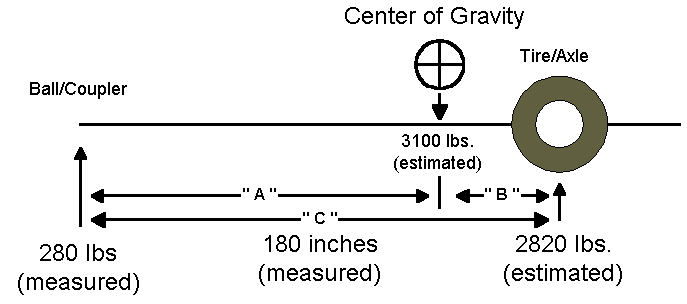
Back to Completed Projects Home
The tongue weight of the trailer seemed excessive, and with the aid of a household scale proved to be 280 lbs.!!! Although this was still within the 5-10 % of total weight guideline; considering I had an extendable trailer tongue, I felt like it was too much. In order to extend the tongue of the trailer, and avoid buckling the extension bar, the trailer tongue weight should be kept to a minimum. At a tongue weight of 280 lbs., I was running the risk of buckling the extension bar.
I wanted to bring the tongue weight down more towards the 5% range. Considering the total load (boat & trailer) is about 3100 lbs., I wanted to shoot for a tongue weight of 160 lbs. (+/-). The tongue weight would be reduced by moving the axle assembly slightly forward.
Diagram of Trailer Weight & Balancing

Adjusting Tongue Weight:
1) I measured weight at the ball/coupler using a household scale.
2) I estimated the total weight of load (boat + trailer), based on the manufacture's data.
3) I measured the distance from the ball to the rear axle and called that distance "C".
4) I found the Center of Gravity by solving for "A" and "B".
I assumed the trailer is not moving, so all forces must be equal. Therefore, I knew the following to be true. . .
(280 * A) = (2820 * B) and (A + B) = C=180 inches
Solving for A and B, . . .
A = ((2820 / 280) * B) or "A" is about 10 times the distance of " B ".
A = 10 * B and (10 * B) + B = C so, (11 * B) = 180 inches
B = 16 inches , A = 164 inches
Adjusting (reducing) the tongue weight was done by moving the axle forward, i.e. shortening "B". "A" will stay the same, as I will not be moving the C. G. (note that the overall measurement "C" will be reduced as well). Using the equation from above and plugging in my target tongue weight (160 lbs.), I calculated the new "B" measurement . . .
(160 * A) = (2940 * B) or (160 lbs. * 164 inches) = (2940 lbs. * B inches)
B = 9 inches So, the axle needs to be moved forward 7 inches (16 - 9).
I was careful to maintain the axle alignment when I moved the axle forward.
The final results, as checked by my household scale, was 155 lbs. (exactly 5%). If I needed more tongue weight for towing (which I did), I could store the rudder assembly in the V-berth, bringing the tongue weight to about 190 lbs.